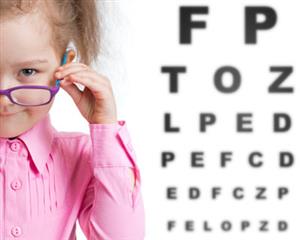What is Myopia?
Myopia, or nearsightedness, is a refractive error, which means that the eye does not bend or refract light properly to a single focus to see images clearly. In myopia, close objects look clear but distant objects appear blurred. Myopia is a common condition that affects an estimated 25 percent of Americans. It is an eye focusing disorder, not an eye disease.
Myopia occurs when the eye is longer than normal or has a cornea (clear front window of the eye) that is too steep. As a result, light rays focus in front of the retina instead of on it. This allows you to see near objects clearly, but distant objects will appear blurred. Click HERE to watch a video about myopia.

Some of the signs and symptoms of myopia include eyestrain, headaches, squinting to see properly and difficulty seeing objects far away, such as road signs or a blackboard at school.
Myopia symptoms may develop in children when they are between ages 8 and 12 years old. During the teenage years, when the body grows rapidly, myopia may become worse. Between the ages of 20 and 40, there is usually little change.
Dr. Banik can diagnose myopia as part of your comprehensive eye examination. She will determine if you have myopia by using a standard vision test, where you are asked to read letters on a chart placed at the other end of the room.
If the myopia is mild, it is called low myopia. Severe myopia is known as high myopia. High myopia will usually stabilize between the ages of 20-30 years old. With high myopia, vision is usually corrected with glasses, contact lenses or sometimes with refractive surgery.
Patients with myopia have a higher risk of developing a detached retina. Dr. Banik will discuss with you the warning signs of retinal detachment with you if you are in this risk category. If the retina does detach and it is discovered early enough, a surgical procedure can usually repair it. It is important to have regular eye examinations by Dr. Banik to watch for changes in the retina that might lead to retinal detachment.
People with high myopia may also have a higher than average risk of developing glaucoma and cataracts.
There is no best method for correcting myopia. The most appropriate correction for you depends on your eyes and your lifestyle. You should discuss your lifestyle with Dr. Banik to decide which correction may be most effective for you.
Eyeglasses or contact lenses are the most common methods of correcting myopia symptoms. They work by refocusing light rays on the retina, compensating for the shape of your eye. Eyeglasses can also help protect your eyes from harmful ultraviolet (UV) light rays. A special lens coating that screens out UV light is available.
In many cases, people may choose to correct myopia with LASIK or another similar form of refractive surgery. These surgical procedures are used to correct or improve your vision by reshaping the cornea, or front surface of your eye, effectively adjusting your eye’s focusing ability.*
*Adapted from www.aao.org
